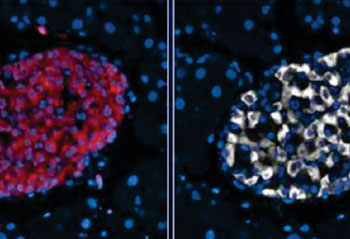Defective Autophagy Triggers Type II Diabetes in Mouse Model
By LabMedica International staff writers
Posted on 05 Aug 2014
A defect in the cellular cleansing process known as autophagy in individuals with type II diabetes causes the build-up of toxic beta-cell amyloid polypeptide (IAPP or amylin), a scenario similar to the build-up of beta amyloid peptides (Abeta) in Alzheimer's disease.Posted on 05 Aug 2014
Autophagy is a self-degradative cellular process that is important for balancing sources of energy at critical times in development and in response to nutrient stress. Autophagy also plays a housekeeping role in removing misfolded or aggregated proteins, clearing damaged organelles, such as mitochondria, endoplasmic reticulum and peroxisomes, as well as eliminating intracellular pathogens. Thus, autophagy is generally thought of as a survival mechanism, although its deregulation has been linked to non-apoptotic cell death. Autophagy can be either non-selective or selective in the removal of specific organelles, ribosomes and protein aggregates, although the mechanisms regulating aspects of selective autophagy are not fully understood.

Image: This beta cell that has non-functioning autophagy shows increased oxidative damage (stained in red) in the pancreatic islets (shown in white) (Photo courtesy of UCLA - University of California, Los Angeles).
Investigators at the University of California, Los Angeles (USA) linked a defect in autophagy to the excess of IAPP seen in patients with type II diabetes. One of the defining features of type II diabetes is insulin resistance. This is a condition wherein the body is unable to utilize insulin effectively, resulting in increased insulin production. Since proinsulin and proIAPP are secreted together, this results in an increase in the production of proIAPP as well. IAPP is a 37-residue peptide hormone that plays a role in glycemic regulation by slowing gastric emptying and promoting satiety, thereby preventing postprandial spikes in blood glucose levels.
For this study the investigators created a novel mouse model that expressed autophagy defects specifically in beta-cells with expression of the human form of islet amyloid polypeptide.
Results published in the July 18, 2014, online edition of the Journal of Clinical Investigation revealed that mice that were hemizygous for transgenic expression of human IAPP did not develop diabetes; however, loss of beta-cell-specific autophagy in these animals induced diabetes, which was attributable to accumulation of toxic human IAPP oligomers and loss of beta-cell mass. In human IAPP-expressing mice that lacked beta-cell autophagy, increased oxidative damage and loss of an antioxidant-protective pathway appeared to contribute to increased beta-cell apoptosis. These findings indicated that autophagy/lysosomal degradation defended beta-cells against toxicity induced by the oligomerization-prone human IAPP.
"Only a few previous studies have reported that autophagy is important for beta cell function and survival," said contributing author Dr. Safia Costes, a postdoctoral researcher in endocrinology, diabetes, and hypertension at the University of California, Los Angeles. "Those studies, however, were not conducted to address the role of this process in the regulation of the amyloidogenic protein, which is an important contributor to type II diabetes. The goal of our work is to understand the cellular mechanisms responsible for beta-cell destruction so that we can identify the best targets for beta-cell protection. This would aid the development of the next generation of treatments as well as combination therapies for type II diabetes."
Results presented in the current study pinpointed similarities between type II diabetes, Alzheimer's disease, and other neurodegenerative diseases that are marked by an accumulation of toxic forms of amyloid proteins. Dr. Costes said, "This demonstrates the importance of autophagy in clearing out these harmful proteins to prevent both type II diabetes and Alzheimer's disease."
Related Links:
University of California, Los Angeles













